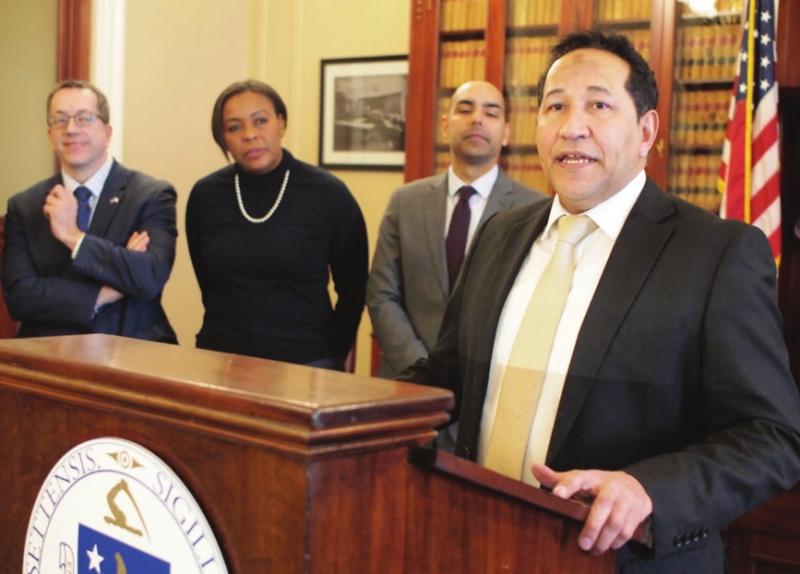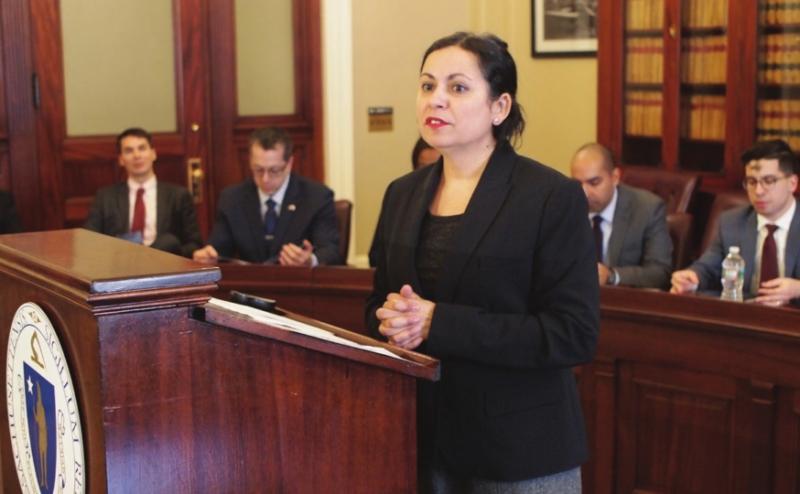
State Rep. Carlos Gonzalez speaks during a presentation on the state’s growing Latino population. Looking on are reps. Aaron Vega, Nika Elugardo and Jon Santiago.

Gaston Institute Director Lorna Rivera speaks during a presentation at the State House.
New study projects population of 1.15 million by 2035
The Massachusetts Latino population is projected to reach 1.15 million in 2035, up from 757,000 in 2015, according to a study released last week by the Mauricio Gaston Institute for Latino Community Development and Public Policy. By 2035, Latinos are expected to account for 15 percent of the state’s population.
The growth in the Latino population will have far-ranging policy implications for how the state provides education, public health and public services, according to academics with the Gaston Institute and members of the Massachusetts Legislative Black and Latino Caucus who gathered at a State House briefing on the report.
Among the findings:
• The Latino population will be younger than the state’s population as a whole, with most falling in the 25-29 age range, while the majority of the overall Massachusetts population is in the 40-44 range.
• While Dominicans and Puerto Ricans make up the majority of the state’s Latino population, people from Mexico and Central and South America also make up a sizeable portion of the community.
• Immigration accounts for much of the Latino community’s population growth, but the majority
of the state’s Latino Population is and will continue to be
native-born. Latinos as a group have a higher birthrate than whites,
African Americans and Asians.
•
The surge in the state’s Latino population is likely to occur in the
state’s so-called gateway cities — post-industrial communities such as
Lawrence and Springfield.
• Ten percent of the state’s 600,000 small businesses are owned by Latinos.
•
With an increased number of native Spanish-speakers in Massachusetts,
more school districts may have to shift away from the sheltered English
immersion model adopted in the state in 2002.
“The
state needs to have other models for bilingual education and think
about opportunities in our schools for increasing the high school
graduation rate for English language learners,” Gaston Institute
Director Lorna Rivera said.
State
Rep. Aaron Vega, whose district includes the city of Holyoke, with a
Latino population of 50 percent, said dual language schools in his city
are popular with both Latino and white families.
Rep.
Nika Elugardo, whose district includes parts of Jamaica Plain,
Roslindale, Mission Hill and Brookline, said it’s incumbent on state and
local government to help communities respond to the needs of the
state’s growing Latino population.
“If
we’re going have a million Latinos in our state, what are we doing for
non-Latinos to make sure that our cultural competence is up to par, to
make sure more people are speaking Spanish, to make sure more businesses
are receiving cultural competence training,” she said.
“The
Latino communities have re-built the economic engines of downtown,”
said Springfield Rep. Carlos Gonzalez, a former president of the Latino
Chamber of Commerce. “We have to concentrate on micro-businesses
development, with under five employees.
Those are the businesses that create 89 percent of the employment in low-income communities.”
As
the Latino population in Massachusetts has grown, so too has the
political clout Latinos have exercised from local school committees to
the State House.
Now,
with seven House members and one senator, Latino political
representation has expanded greatly since 1989, when former Rep. Nelson
Merced became the first Latino elected to the State House. Merced’s
victory, in the 5th Suffolk District seat currently held by Cape
Verdean-American Liz Miranda, came after members of the
then-Massachusetts Black Legislative Caucus advocated for the district
to be redrawn so a Latino candidate could win election there.
The Black Caucus admitted Latino members for years before adding the word “Latino” to its name in 2009.
Gonzalez,
who is the current chairman of the Caucus, noted that Latino electoral
clout is growing in cities such as Springfield as Latino communities
become better established. There are now two Latinas on the Springfield
School Committee and two Latinos in the city council. Gonzalez said the
Latino elected officials in Springfield work closely with the two
African Americans on the school committee and five African Americans on
the council.
“We’re a
very cohesive group, working together,” he said. “We understand the
issues are the same in black and brown communities.”
In
addition to Vega, Elugardo and Gonzalez, other Caucus members in
attendance at the Gaston Institute briefing included Haverhill Rep. Andy
Vargas and Boston Rep. Jon Santiago, whose district includes parts of
the South End and Roxbury neighborhoods.